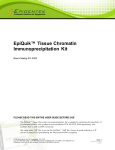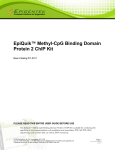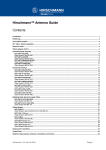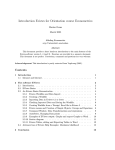Download EpiQuik™ Global Histone H4 Acetylation Assay Kit
Transcript
EPIGENTEK Complete Solutions for Epigenetics EpiQuik™ Global Histone H4 Acetylation Assay Kit Base Catalog # P-4009 PLEASE READ THIS ENTIRE USER GUIDE BEFORE USE The EpiQuik™ Global Histone H4 Acetylation Assay Kit is suitable for specifically measuring global histone H4 acetylation using a variety of mammalian cells including fresh and frozen tissues, and cultured adherent and suspension cells. 110 Bi County Blvd. Ste. 122, Farmingdale, NY 11735 Tel: 1-877-374-4368 ■ Fax: 1-718-484-3956 ■ E-mail: [email protected] ■ Web: www.epigentek.com © Epigentek Group Inc. All rights reserved. Products are for research use only. Page 1 Printed 2014-10-06 P-4009 EPIGENTEK Complete Solutions for Epigenetics KIT CONTENTS Components 48 a ssays P-4009-48 96 a ssays P-4009-96 GE1 (10X Lysis Buffer) GE2 (Extraction Buffer) GE3 (10X Wash Buffer) GE4 (Histone Buffer) GE5 (Blocking Buffer) GE6 (Antibody Buffer) GE7 (Capture Antibody, 100 µg/ml)* GE8 (Detection Antibody, 400 µg/ml)* GE9 (Developing Solution) GE10 (Stop Solution) Acetylated Histone H4 Control (60 µg/ml)* 8-Well Assay Strips (with Frame) User Guide 5 ml 8 ml 14 ml 0.5 ml 10 ml 6 ml 25 µl 10 µl 5 ml 3 ml 10 µl 6 1 10 ml 16 ml 28 ml 1 ml 20 ml 12 ml 50 µl 20 µl 10 ml 6 ml 20 µl 12 1 * For maximum recovery of the products, centrifuge the original vial prior to opening the cap. SHIPPING & STORAGE The kit is shipped in two parts: one part at ambient room temperature, and the second part on frozen ice packs at 4°C. Upon receipt: (1) Store GE8 and Acetylated Histone H4 Control at –20°C away from light; (2) Store GE3, GE5, GE6, GE7, GE9, and 8-Well Assay Strips at 4°C away from light; (3) Store a ll other components at room temperature. The components of the kit are stable for up to 6 months, when stored properly. Note: Check if wash buffer, GE3, contains salt precipitates before using. If so, warm (at room temperature or 37°C) and shake the buffer until the salts are re-dissolved. MATERIALS REQUIRED BUT NOT SUPPLIED Orbital Shaker Pipettes and Pipette Tips Microplate Reader 1.5 ml Microcentrifuge Tubes 60 or 100 mm Plate Dounce Homogener 100 % TCA Solution 110 Bi County Blvd. Ste. 122, Farmingdale, NY 11735 Tel: 1-877-374-4368 ■ Fax: 1-718-484-3956 ■ E-mail: [email protected] ■ Web: www.epigentek.com © Epigentek Group Inc. All rights reserved. Products are for research use only. Page 2 Printed 2014-10-06 P-4009 EPIGENTEK Complete Solutions for Epigenetics Glycerol Acetone 5% HCl Distilled Water GENERAL PRODUCT INFORMATION Usage Limitation: The EpiQuik™ Global Histone H4 Acetylation Assay Kit is for research use only and is not intended for diagnostic or therapeutic application. Sa fety: Suitable lab coat, disposable gloves, and eye protection is required when working with the kit. Qua lity Control: Epigentek guarantees the performance of all products in the manner described in our product instructions. Product Updates: Epigentek reserves the right to change or modify any product to enhance its performance and design. Intellectual Property: EpiQuik™ is a trademark of Epigentek, Inc.The EpiQuik™ Global Histone H4 Acetylation Assay Kit and method of use contain proprietary technologies by Epigentek. A BRIEF OVERVIEW Acetylation of histones, including histone H4, has been involved in the regulation of chromatin structure and the recruitment of transcription factors to gene promoters. Histone acetyltransferases (HATs) and histone deacetylases (HDACs) play critical roles in controlling histone acetylation. Histone acetylation is tightly involved in cell cycle regulation, cell proliferation, and apoptosis. Reversible acetylation of nucleosomal histones H4 generally is believed to be correlated with potential transcriptional activity of eukaryotic chromatin domains. Histone H4 acetylation may be increased by inhibition of HDACs and decreased by HAT inhibition. There are very few methods used for measuring global histone H4 acetylation. The EpiQuik™ Global Histone H4 Acetylation Assay Kit addresses this problem by providing a unique procedure to measure global acetylation of histone H4. The kit has the following features: Quick and efficient procedure, which can be finished within 5 hours. Innovative colorimetric assay without the need for radioactivity, electrophoresis, or chromatography. Strip microplate format makes the assay flexible: manual or high throughput. Simple, reliable, and consistent assay conditions. 110 Bi County Blvd. Ste. 122, Farmingdale, NY 11735 Tel: 1-877-374-4368 ■ Fax: 1-718-484-3956 ■ E-mail: [email protected] ■ Web: www.epigentek.com © Epigentek Group Inc. All rights reserved. Products are for research use only. Page 3 Printed 2014-10-06 P-4009 EPIGENTEK Complete Solutions for Epigenetics PRINCIPLE & PROCEDURE The EpiQuik™ Global Histone H4 Acetylation Assay Kit is designed for measuring global histone H4 acetylation. In an assay with this kit, the histone proteins are stably spotted on the strip wells. The acetylated histone H4 can be recognized with a high-affinity antibody. The ratio or amount of acetylated H4 can be quantified through HRP conjugated secondary antibody-color development system and is proportional to the intensity of color development. Fi g1. Schematic Procedure for Using the EpiQuik™ Global Histone H4 Acetylation Assay Kit PROTOCOL Nucleic Ex tra ction Prep a ra tion For Tissue Samples: 1. Place the tissue sample into a 60 or 100 mm plate. Remove unwanted tissue such as fat and necrotic material from the sample. Weigh the sample and cut the sample into small pieces (1-2 mm3) with a scalpel or scissors. 2. Transfer tissue pieces to a Dounce homogenizer. Dilute GE1 with distilled water (pH 7.2 to 7.5) at a 1:10 ratio (e.g., 1 ml of GE1 + 9 ml of distilled water). Add 1 ml of the d iluted GE1 per every 200 mg of tissue and disaggregate tissue pieces by 10-30 strokes. 110 Bi County Blvd. Ste. 122, Farmingdale, NY 11735 Tel: 1-877-374-4368 ■ Fax: 1-718-484-3956 ■ E-mail: [email protected] ■ Web: www.epigentek.com © Epigentek Group Inc. All rights reserved. Products are for research use only. Page 4 Printed 2014-10-06 P-4009 EPIGENTEK Complete Solutions for Epigenetics 3. Transfer homogenized mixture to a 15 ml conical tube and centrifuge at 3000 rpm for 5 minutes at 4°C. If total mixture volume is less than 2 ml, transfer mixture to a 2 ml vial and centrifuge at 10,000 rpm for 1 minute at 4°C. Remove supernatant. For Adherent Cells: 1. Cells (treated or untreated) are grown to 70-80% confluency, then trypsinized and collected into a 15 ml conical tube. Count cells in a hemacytometer. 2. Centrifuge the cells at 1000 rpm for 5 minutes and discard the supernatant. Wash cells with 10 ml of PBS once by centrifugation at 1000 rpm for 5 minutes. Discard the supernatant. 3. Add d iluted GE1 to re-suspend cell pellet (200 µl/1 x 106 cells). Transfer cell suspension to a 1.5 ml vial and incubate on ice for 5 minutes and vortex occasionally. 4. Pellet cell debris by centrifuging at 12,000 rpm for 30 seconds. For Suspension Cells: 1. Collect cells (treated or untreated) into a 15 ml conical tube. (1-2 x 106 cells are required for each reaction). Count cells in a hemacytometer. 2. Centrifuge the cells at 1000 rpm for 5 minutes and discard the supernatant. Wash cells with 10 ml of PBS once by centrifugation at 1000 rpm for 5 minutes. Discard the supernatant. 3. Add d iluted GE1 to re-suspend cell pellet (100 µl/1 x 106 cells). Transfer cell suspension to a 1.5 ml vial and incubate on ice for 5 minutes and vortex occasionally. 4. Pellet cell debris by centrifuging at 12,000 rpm for 30 seconds. Histone Ex tra ction 1. Add glycerol to GE2 at a 1:10 ratio (e.g., add 100 µl of glycerol to 900 µl of GE2) to prepare the GE2/Glycerol Solution. Add the d iluted GE1 to cell debris (10 µl/1 x 106 cells or 40 mg of tissue), followed by adding 3 volumes of GE2/Glycerol Solution. Mix by vortexing and incubate on ice for 5 minutes. 2. Pellet nucleic debris by centrifuging at 12,000 rpm for 5 minutes at 4°C. Transfer the supernatant to a 1.5 ml vial. 3. Add 100% TCA to the supernatant at a 1:4 ratio (ex: add 100 µl of TCA to 300 µl of supernatant. Final concentration of TCA should be 25%). Incubate on ice for 30 minutes. 4. Collect the precipitate by centrifuging at 12,000 rpm for 10 minutes at 4°C. 5. Remove supernatant and add 1 ml of acetone containing 0.1% HCl to precipitate. Mix and incubate on ice for 1 minute. 6. Collect the pellet by centrifuging at 12,000 rpm for 2 minutes at 4°C. Wash the pellet with 1 ml of acetone. Allow 1 minute on ice for wash. 7. Collect the pellet by centrifuging at 12,000 rpm for 2 minutes at 4°C. Remove the supernatant as much as possible and air dry the pellet for 5 minutes. 8. Add distilled water to dissolve pellet (10 µl of water per amount of pellet extracted from 1 x 10 6 cells or 40 mg of tissue) and measure histone protein concentration. The histone extract can be used immediately or stored at –80°C. 110 Bi County Blvd. Ste. 122, Farmingdale, NY 11735 Tel: 1-877-374-4368 ■ Fax: 1-718-484-3956 ■ E-mail: [email protected] ■ Web: www.epigentek.com © Epigentek Group Inc. All rights reserved. Products are for research use only. Page 5 Printed 2014-10-06 P-4009 EPIGENTEK Complete Solutions for Epigenetics Histone H4 Acetyla tion Detection 1. Determine the number of strip wells required. Leave these strips in the plate frame (remaining unused strips can be placed back in the bag. Seal the bag tightly and store at 4°C). Dilute GE3 with distilled water (pH 7.2-7.5) at a 1:10 ratio. 2. Adjust protein concentration to 200 ng/µl or 400 ng/µl with GE4 and add 5 µl (1-2 µg) of the protein solution into the central area of each well. Spread out the solution over the strip well surface by pipetting the solution up and down several times. Incubate the strip wells at 37°C (with no humidity) for 60-90 minutes to evaporate the solution and dry the wells. For the blank, add 5 µl of GE4 to the wells. For the positive control, dilute Acetylated Histone H4 Control to 2-30 ng/µl with GE4 and add 5 µl (10-150 ng) of the d iluted Acetylated Histone H4 Control solution to the wells. 3. Add 150 µl of GE5 to the dried wells and incubate at 37°C for 30 minutes. 4. Aspirate and wash the wells with 150 µl of d iluted GE3 three times. 5. Dilute GE7 (at a 1:100 ratio) to 1 µg/ml with GE6. Add 50 µl of d iluted GE7 to the wells and incubate at room temperature for 60 minutes on an orbital shaker (50-100 rpm). 6. Aspirate and wash the wells with 150 µl of d iluted GE3 four times. 7. Dilute GE8 (at a 1:1000 ratio) to 0.4 µg/ml with GE6. Add 50 µl of d iluted GE8 to the wells and incubate at room temperature for 30 minutes. 8. Aspirate and wash the wells with 150 µl of d iluted GE3 four times. Allow 3 minutes for the last wash. 9. Add 100 µl of GE9 to the wells and incubate at room temperature for 2-10 minutes away from light. Monitor the color development in the sample and standard wells (blue). 10. Add 50 µl of GE10 to the wells and read absorbance on microplate reader at 450 nm. 11. Calculate % Histone H4 acetylation: Acetylation % = OD (sample – blank) OD (untreated control – blank) × 100% For accurate calculation, plot OD value versus amount of Acetylation Histone H4 Control and determine the slope as delta OD/ng. Calculate the amount of acetylation H4 using the following formula: OD (sample – blank) Amount (ng/mg protein) = × 1000 slope 110 Bi County Blvd. Ste. 122, Farmingdale, NY 11735 Tel: 1-877-374-4368 ■ Fax: 1-718-484-3956 ■ E-mail: [email protected] ■ Web: www.epigentek.com © Epigentek Group Inc. All rights reserved. Products are for research use only. Page 6 Printed 2014-10-06 P-4009 EPIGENTEK Complete Solutions for Epigenetics TROUBLESHOOTING No Signal for Both the Positive Control and the Samples Reagents are added incorrectly. Check if reagents are added in order and if any steps of the procedure may have been omitted by mistake. The well is not completely dried. Ensure the well is incubated without humidity and dried before adding GE5 (Blocking Buffer). The well is incorrectly washed before protein coating. Ensure the well is not washed before adding the positive control or protein extracts. Incubation time and temperature is incorrect. Ensure the incubation time and temperature described in the protocol are followed correctly. No Signal or Very W eak Signal for Only the Positive Control The positive control is added Ensure a sufficient amount of control is added to insufficiently. the well. The positive control degraded due to incorrect storage. Follow the guidance in the protocol for storage of the positive control. No Signal for Only the Sample The protein sample is not properly extracted. Follow the protocol instructions for the histone protein extraction. The protein amount is added into well insufficiently. Ensure extract contains a sufficient amount of protein. Protein extracts are incorrectly stored or have been stored for a long period. Ensure the protein extracts are stored at –80°C for no more than 3 months. Hig h Background Present for the Blank The well is not washed sufficiently. Check if wash at each step is performed according to the protocol. Contaminated by the positive Ensure the well is not contaminated from adding 110 Bi County Blvd. Ste. 122, Farmingdale, NY 11735 Tel: 1-877-374-4368 ■ Fax: 1-718-484-3956 ■ E-mail: [email protected] ■ Web: www.epigentek.com © Epigentek Group Inc. All rights reserved. Products are for research use only. Page 7 Printed 2014-10-06 P-4009 EPIGENTEK Complete Solutions for Epigenetics control. Overdevelopment. the control protein or by using control protein contaminated tips. Decrease development time in Step 9 of “Histone H4 Acetylation Detection”. RELATED PRODUCTS P-3015 P-3016 P-3017 P-3018 P-4008 EpiQuik™ EpiQuik™ EpiQuik™ EpiQuik™ EpiQuik™ In Situ Histone H3-K4 Methylation Assay Kit In Situ Histone H3-K9 Methylation Assay Kit Global Histone H3-K4 Methylation Assay Kit Global Histone H3-K9 Methylation Assay Kit Global Histone H3 Acetylation Assay Kit 110 Bi County Blvd. Ste. 122, Farmingdale, NY 11735 Tel: 1-877-374-4368 ■ Fax: 1-718-484-3956 ■ E-mail: [email protected] ■ Web: www.epigentek.com © Epigentek Group Inc. All rights reserved. Products are for research use only. Page 8 Printed 2014-10-06 P-4009











